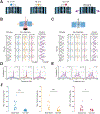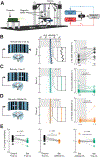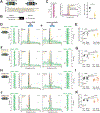Proprioception gates visual object fixation in flying flies
- PMID: 37001520
- PMCID: PMC10133043
- DOI: 10.1016/j.cub.2023.03.018
Proprioception gates visual object fixation in flying flies
Abstract
Visual object tracking in animals as diverse as felines, frogs, and fish supports behaviors including predation, predator avoidance, and landscape navigation. Decades of experimental results show that a rigidly body-fixed tethered fly in a "virtual reality" visual flight simulator steers to follow the motion of a vertical bar, thereby "fixating" it on visual midline. This behavior likely reflects a desire to seek natural features such as plant stalks and has inspired algorithms for visual object tracking predicated on robust responses to bar velocity, particularly near visual midline. Using a modified flight simulator equipped with a magnetic pivot to allow frictionless turns about the yaw axis, we discovered that bar fixation as well as smooth steering responses to bar velocity are attenuated or eliminated in yaw-free conditions. Body-fixed Drosophila melanogaster respond to bar oscillation on a stationary ground with frequency-matched wing kinematics and fixate the bar on midline. Yaw-free flies respond to the same stimulus by ignoring the bar and maintaining their original heading. These differences are driven by proprioceptive signals, rather than visual signals, as artificially "clamping" a bar in the periphery of a yaw-free fly has no effect. When presented with a bar and ground oscillating at different frequencies, a yaw-free fly follows the frequency of the ground only, whereas a body-fixed fly robustly steers at the frequencies of both the bar and ground. Our findings support a model in which proprioceptive feedback promote active damping of high-gain optomotor responses to object motion.
Keywords: feature detection; fly vision; navigation; optomotor.
Copyright © 2023 The Author(s). Published by Elsevier Inc. All rights reserved.
Conflict of interest statement
Declaration of interests The authors declare no competing interests.
Figures






References
-
- Reichardt W, and Wenking H (1969). Optical detection and fixation of objects by fixed flying flies. Naturwissenschaften, 424. - PubMed
-
- Poggio T, and Reichardt W (1973). A theory of the pattern induced flight orientation of the fly Musca domestica. Kybernetik, 185–203. - PubMed
-
- Reichardt W, Poggio T, and Hausen K (1983). Figure -ground discrimination by relative movement in the visual system of the fly. Biol. Cybern 46, 1–30.
Publication types
MeSH terms
Grants and funding
LinkOut - more resources
Full Text Sources
Molecular Biology Databases

